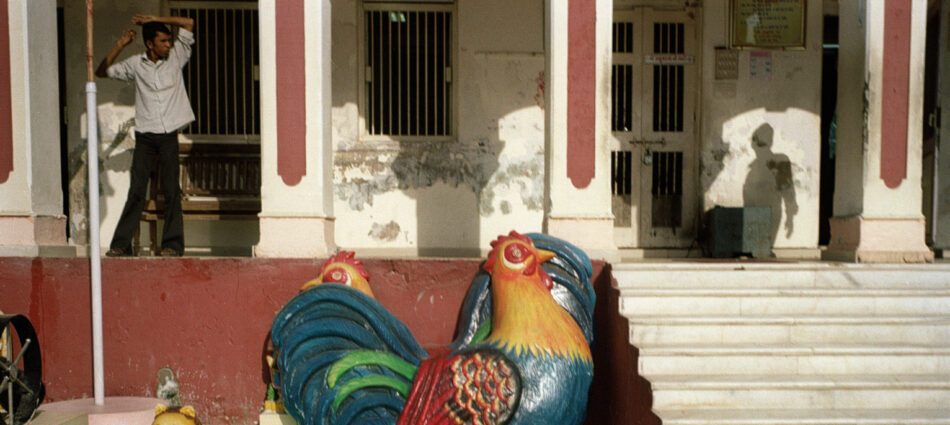
The Goddess Of The Sea
Some days later, there was a wild dance of the elements in Ponnani sea. The heavy clouds burst and brought the heavens down to meet the sea, which reached up and met it halfway, rising in mountainous waves…A fishing boat overturned. The sons of Ponnani were thrown into the water looked around in terror. All around they could see nothing but water. The horizon itself looked like another sea…
Ramanunni What The Sufi Said
Her naked body emerges from the storm-tossed ocean waves and the fishermen, thrown from their boats, cling to it for safety. The corpse is strangely warm but it reminds the men of the solace and safety of their mother’s bosom. It drags them to the safety of the shore, and the men are overwhelmed by her beauty – a beauty that calls forth veneration and reverence. They cover her with their own clothes, and dig her a grave. Angry at the sea goddess, they build a shrine and begin to worship her and seek her protection.
This is the story that the Keralan writer Ramanunni weaves in his work What The Sufi Said to explain the story of Manubam Bibi whose shrine near the town of Ponnani I have come to visit. Located spectacularly on the edge of a peninsula facing a raging sea, Manubam Bibi’s shrine is revered by Hindus and Muslims from across the region. The shrine, now remodeled along a typically North Indian style dargah complete with minarets and an imposing dome, is surrounded by the homes of local fishermen.
There is an incongruity between the architecture of the shrine and the surrounding environment of sea, sand, palms and beautiful, single storied thatched roof homes. The shrine’s materials of cement, steel and asphalt suggesting an imposition of an imagination from outside the locale. The fishermen’s family homes seems to blend in with the world around them, reflecting the colors, textures and materials of nature itself. I have to believe that the shrine did the same once, but that new ideals perhaps imported from the North of India, or even the Gulf where many Keralan’s travel for employment, have had their effect.
But regardless, it is the ocean that defines the world here, and as its waves crash angrily against the walls of the shrine, it underlines the meaning of the shrine and the abode of the goddesses herself. The shrine is merely a symbol. The ocean has always held a powerful influence on the imagination of man. Gods and goddesses have been attributed to it. I am more familiar with the Greek traditions – the goddess Amphitrite, the wife of the sea-god Poseidon, who was possibly one of the fifty Nereids – nymphs of the sea, or perhaps even a Oceanides, one of the three thousand goddesses of the sea. But it is quite thrilling to discover that here in Kerala’s north, the fishermen also see the sea as a goddess – one who protects, wrecks vengeance, nurtures and destroys.
Manubam Bibi is a Muslim female saint associated with the sea. In this she mirrors the legends of many Hindu goddesses associated with the sea. Her devotees come from all faiths, and once again it is a legend that weaves the communities together. The inter-connectedness of the faiths of the land are also the fundamental idea behind Ramanunni’s novel, which, much like the regions folk poetry, speaks against the divisiveness of faiths and seeks to highlight the common aspirations of all men and women. Ramanunni has woven this sea goddesses story into a tragic tale of love – that between a Hindu girl and a Muslim boy. As Dominique-Sila Khan points out in her work Sacred Kerala, while discussing this novel, the beautiful Hindu devotees of Bhagavati who marries a Muslim boy is written as an incarnation of this goddess of the sea.
Manunbam Bibi is not the first female saint I have knelt before. As I step out of the shrine’s inner chamber and push past a crowd of people trying to get inside, I think of the shrine of Badi Bua in Ayodhya, Uttar Pradesh, considered the most powerful of saints in the region. I wrote about her in a post called The Saints Of Ayodhya: Sufis In The Hindu City stating that:
One of the most important and revered shrines in the city is to a woman saint by the name of Badi Bua, or Badi Bibi. She was not only considered one of the most beautiful women in the city, but created enemies amongst the local clergy by refusing to marry and devote her life towards the worship of God. When approached by a local suitor who claimed that he was in love with her eyes, she by legend plucked them out and gave them to him.
Today her shrine lies on the outskirts of the city, amongst a small but tense forest of trees, surrounded by the decaying graves of local aristocracy. Every hour or so an individual arrives and sits in quiet meditation speak to her and cleaning the leaves, dead flowers and dust from the tombstone. Unlike a mosque, a shrine is often a place for individual devotion.
I prayed at Badi Bua’s shrine. As a non-religious, anti-clerical secularist I nevertheless carry faith (I hold it as a given that all men of theology and the philosophy of theology are hypocrites and men without faith). The prayer came true. I am now under obligation to return to Ayodhya, and to her shrine, to pay my respects to her once again. I prayed at the Manubam Bibi shrine. I would love to come back to pay my respects here too.


Pingback: The Idea Of India Project Update: Continuing The Search For The Female Sufi Saints And Finding The Business Of The Blessing « The Spinning Head
Pingback: sea deities - Religious Education Forum